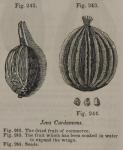 (Fructus: Java Cardamom, offic.)
(Fructus: Java Cardamom, offic.)
History.—This plant was first described by Roxburgh. [Asiatic Researches, xi. p. 344.]
Botany. Gen. Char.—Vide Amomum Cardamomum.
Sp. Char.—Leaves stalked, lanceolate, villous underneath. Spikes oval, even with the earth. Bracts lanceolate. Lip elliptical. Coronet of one semilunar lobe. Capsules round, 9-winged. (Roxburgh.)
The capsule is "almost globular, size of a gooseberry, 3-celled, 3-valved, ornamented with nine [seven to thirteen, Blume] firm, short, ragged (when old and dry), membranaceous wings. The seeds possess a warm, pungent, aromatic taste, not unlike that of cardamoms, but by no means so grateful." (Roxburgh.) The Nepal cardamom, described by Dr. Hamilton, [An Account of the Kingdom of Nepal, ed. 1819.] appears to be identical with the Java cardamom. Dr. Hamilton says, the plant yielding it "is a species of Amomum, as that genus is defined by Dr. Roxburgh, and differs very much from the cardamom of Malabar."
Hab.—The Malay Islands (Roxburgh); Java (Blume). Cultivated in the mountainous parts of Nepal, where it is propagated by cuttings of the root [rhizome]; the plants yield in three years, and afterwards give an annual crop (Hamilton).
Description.—The fruit of this plant is known in commerce by various names; such as greater Java cardamoms (cardamomi majores javanenses, Th. Martius; Java cardamoms, offic; Nepal cardamoms, desi elachi [i. e. country cardamoms] of Hindustan, Hamilton; the bura elachee [i. e. great cardamoms] of Saharunpore—the Bengal cardamoms of the Calcutta market, Royle; cardamome ailé de Java and cardamome fausse maniguette, Guibourt) are oval or oval-oblong, frequently somewhat ovate, three-valved, from eight to fifteen lines long, and from four to eight lines broad, usually flattened on one side, convex on the other, occasionally curved, sometimes imperfectly three-lobed, and resembling in their form the pericarp of the cocoa-nut (Fig. 242). Their colour is dirty grayish-brown. They have a coarse, fibrous, aged appearance, are strongly ribbed, and when soaked in hot water (Fig. 243) become most globular, and present from nine to thirteen ragged, membranous wings, which occupy the upper half or three-fourths of the capsule, and are scarcely perceptible in the dried state of the pericarp. By the possession of wings, these cardamoms are distinguished from all others of commerce, and hence might be called the winged cardamoms. Occasionally the footstalk is attached, with, now and then, portions of brown, membranous, imbricated scales, as long as the fruit. At the opposite or winged extremity of the capsule are frequently the fibrous remains of the calyx. Seeds (Fig. 244) somewhat larger than grains of paradise, dull, dirty brown, with a shallow groove on one side, internally white; taste and odour feebly aromatic. One hundred parts of the fruit consist, according to Th. Martius, [Pharmacognosie.] of seventy parts seeds, and thirty parts pericarpial coats. They are imported from Calcutta in bags.
Composition.—Analogous probably to that of the Malabar cardamom, except in the quantity of volatile oil which it yields; for Martius procured only four scruples of it from a pound of the fruit. The oil obtained was white and thickish.
Effects and Uses.—Java cardamoms are not used here. They are of inferior quality, and when brought to this country are usually sold in bond for continental use. In 1839, a quantity of them was sold at seven-pence per lb.

